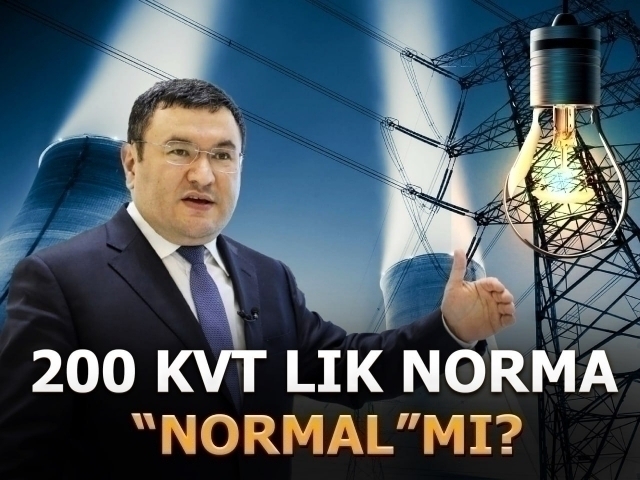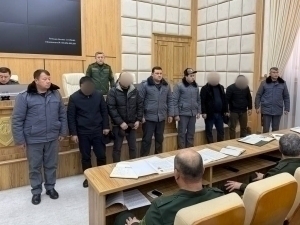Is the 200 kW limit reasonable?
Review
−
09 July 2024 39226 9 minutes
Uzbeks are facing challenges in accessing crucial energy resources like gas and electricity. Recently, there has been widespread discontent over the rising cost of electricity and the newly imposed usage limit. It's no wonder that many are already anxious about the upcoming winter, anticipating further hardships.
The 200 kW usage cap, enforced by the government since May, has significantly restricted electricity consumption for the populace. After enduring severe cold without adequate electricity, Uzbeks now face the need to conserve power during the summer heat. Social media is abuzz with complaints directed at the Ministry of Energy and the government. Some citizens are calling for the removal of the 200 kW limit, while others advocate for an increase to at least 500 kW. On July 9, the Ministry of Energy stated there was no justification to raise the 200 kW limit, citing that 71% of consumers stayed within the limit. However, media surveys suggest otherwise.
Is the social norm of 200 kW sufficient?
Why is the social norm set at 200 kW? The Ministry of Energy states that the average electricity consumption in Uzbekistan is 200 kW per household. However, international data paints a different picture. Wikipedia indicates that an individual in Uzbekistan uses about 141 kW of electricity monthly. This means that even with just two people in a household, the consumption would surpass the 200 kW norm. Consider how much more an average family of 4-5 members would use.
Let's examine power consumption from another perspective:
The average monthly electricity usage of household appliances globally is considered here. Excluding internet providers, mobile phone chargers, and other significant power-consuming devices, the consumption still exceeds 500 kW. Did the Uzbek government account for the essential daily life appliances' electrical demands?
In 2019, benchmarking was tested. "Uzbekenergo" JSC announced a monthly rate of 300 kW for the Yunusabad district in Tashkent. By 2022, the social norm was adjusted to 250 kW. However, how this 300 kW norm was further reduced to 200 kW in 2024, when the tariff-based system was applied nationwide, remains unclear. Moreover, no report has been provided on the outcomes of the Yunusabad experiment.
While consumers argue that 200 kW is insufficient, the government has not responded. A poll on QALAMPIR.UZ's Telegram page revealed that over half of the respondents consume more electricity than the social norm. Out of over 18,000 participants, 23 percent reported using up to 200 kW per month, while over 57 percent used between 200 kW and 1000 kW. It's important to note the significant tariff difference between 200 kW and 1000 kW, meaning most people pay the same rate as those who use 1000 kW, regardless of whether they consume 205 kW, 300 kW, or 900 kW.
Where did the cost of 1000 soms come from?
The government states that the cost of electricity is 1,002 soums (895 soums excluding VAT) and claims it is being provided to the public at a loss of 2-3 times the cost. Despite this, the Ministry of Energy has not given any cost estimates or supporting evidence. In Uzbekistan, the majority of electricity is produced by coal-fired thermal power plants. According to "Uzbekkomir" JSC, these plants receive coal at a rate of 430,000 soums per ton. Each kilogram of coal burned produces 8 kW of electricity.
430 (cost of 1 kg of coal) ÷ 8 (electricity produced in kW) = 53 soums (cost of generating 1 kW of electricity).
Thus, the cost of the primary raw material, 1 kg of coal, is 53 soums per 1 kW of electricity. This means that generating 1 kW of electricity at the IES requires burning coal worth 53 soums. This calculation also covers expenses like raw material transportation, employee wages, electricity supply, and other related costs. What factors cause the overall cost to increase 18 times to reach 1002 soums?
Since 2020, President Shavkat Mirziyoyev has consistently directed energy companies to lower electricity costs. He has declared that 2024 will be dedicated to cost reduction and economic efficiency.
Many people advocate for the public to inquire and hold energy workers accountable rather than making demands. For instance, Alisher Kadyrov, the deputy speaker of the Legislative Chamber, supported the energy companies' cost claims and suggested implementing a 200 kW limit if required.
“Mistakes from the past create today's problems, which need to be resolved now to avoid recurring issues in the future. The price for 1 kilowatt of electricity is 990 soums! Offering up to 200 kilowatts at 450 soums and up to 1000 kilowatts at 900 soums should be viewed as support measures, not as demand-driven pricing.
The quicker the energy sector shifts to a market-based system, the more rapidly our economy will grow, job opportunities will expand, people's incomes will rise, and supply systems will better meet demand," he stated.
Economists argue that Uzbekistan's energy system cannot be reformed merely by focusing on costs and increasing prices. To transition to market-based relations, the state monopoly must be dismantled first. Responding to Alisher Qodirov, economist Abdulla Abduqodirov wrote:
"We need to examine the issue more comprehensively. Firstly, the 450 soums standard is ineffective because the electricity meters are not compatible. Secondly, reforming through tariffs alone is insufficient. Thirdly, without competition in production, distribution, and sales, neither the public nor the state benefits."
How transparent are electricity meters?
In October of last year, President Shavkat Mirziyoyev criticized the fact that 28% of wholesale electricity consumers in the country are not connected to the automated system. It was also mentioned that over 170,000 subscribers are not linked to the automated system. Thus, before transitioning to the new tariff system, did the Ministry of Energy address these issues and ensure the installation of accurately functioning meters in every household in the republic?
QALAMPIR.UZ conducted a survey on their Telegram page regarding this issue. Among more than 15,000 participants, 72 percent expressed their lack of trust in the transparent operation of electricity meters. Complaints about malfunctioning electricity meters have surged on social media. For instance, journalist Yulduz Ochilova reported that her electric meter's numbers were increasing even when no one was home:
"Yesterday, on July 1, at 5 PM, we 'used' over 19 kW in less than a day. During the day, the air conditioner was off, we were not home, and we even turned off the heater," she stated.
A similar issue was noted by Umid Gafurov, founder of the Telegram channel "Troll.uz".
"To give you an idea, 314 kW/h was recorded in our house, where no one has lived for a month. I didn't even want to write about it... Okay. I will figure it out when I get back. Something is off with the billing. I couldn't fully understand it," wrote Umid Gofurov.
The Competition and Consumer Protection Committee has announced it will investigate following a series of similar complaints. A working group will be formed by the committee to address the issue. Questions remain about whether overcharged amounts by faulty meters will be refunded to consumers and if the Ministry of Energy will take responsibility for the defective meters.
Economist Otabek Bakirov insists on thoroughly investigating the root cause of the meter issues.
"Historically, inaccuracies in electricity usage calculations were overlooked by consumers until sharp tariff increases began to impact their wallets.
Had the regulatory committee initially focused on the installation sketches used in their studies, they could have identified the root of the problem. Firstly, these sketches, inflated in cost and reset multiple times for embezzlement purposes, highlight a systemic issue. Secondly, despite being termed 'smart', these systems fail to live up to their name. Thirdly, verifying that averaging algorithms in calculations are fair to consumers is crucial for resolving this issue. Otherwise, major energy companies may disregard consumer concerns, leaving them high and dry from their comfortable offices," the economist stated.
Is Uzbekistan home to the highest electricity tariffs in Central Asia?
Within Central Asia, residents of Kazakhstan and Uzbekistan contend with the highest electricity tariffs.
In Kyrgyzstan, the social standard sets consumption at 700 kW. Prices stand at 1.11 soums per kWh (162 thousand soums) for the first 700 kW and increase to 2.39 soums (349 thousand soums) for usage exceeding 700 kW. Unlimited electricity users pay 3.63 soums per kWh (531 soms).
Tajikistan does not limit electricity consumption, pricing 1 kWh at 30.75 dirhams (360 soms).
Turkmenistan uniquely offers free electricity to its citizens, distinguishing it as the sole country in Central Asia with this benefit.
The "reform" that the people could not accept
The increase in prices did not consider the socio-economic status and real-life monthly incomes of Uzbeks, which are not accurately reflected in Statistics Agency data. The Ministry of Energy has not adequately explained to the public why prices have risen. However, in September 2023, Energy Minister Jorabek Mirzamahmudov stated to QALAMPIR.UZ that electricity prices would only rise if the state could ensure uninterrupted supply to consumers.
Mirzamahmudov emphasized, 'Before implementing differentiated tariffs, we must guarantee continuous electricity supply. If prices rise without stable supply, it will understandably provoke public objection. Therefore, we are currently expediting generation increases and network modernization.'
Despite unreliable electricity supply, prices were increased.
Economics Doctor and Professor Tolqin Boboqulov criticized the decision to raise energy prices, highlighting the risks faced by the government:
"Increasing electricity and gas prices will inevitably cause price hikes across other sectors. Moreover, compensating the population will strain the state budget further. It's clear this reform won't be effective. Raising fuel and energy prices during a period of intense inflationary pressure is counterproductive. Simply increasing prices won't solve our energy problems; inflation will persist. If the government aimed to use compensation mechanisms effectively, it should have undertaken comprehensive, long-term strategies. For instance, subsidizing producers while concurrently boosting household incomes. Without this holistic approach, success isn't feasible. We'll witness the adverse effects of these price increases within six months. By then, it'll be evident that this decision was a mistake.”
The government is holding consumers responsible for power outages, urging the population to use electricity more sparingly. However, practical measures to promote the adoption of energy-efficient devices are not being implemented.
For instance, refrigerators with 70 Volt energy efficiency are currently being manufactured, yet there are limitations on their availability in Uzbekistan's markets. These restrictions contribute to higher prices for imported household appliances.
What lies ahead for Uzbekistan, which seems to be making one step forward and two steps back in energy reforms? Uzbeks face a challenging winter ahead. The cost of electricity ("svet") will also be impacted by increased gas prices. Following winter, in April 2025, electricity prices will rise again. Despite our words, we encourage patience among the populace and honesty among those in leadership positions.
Live
All




